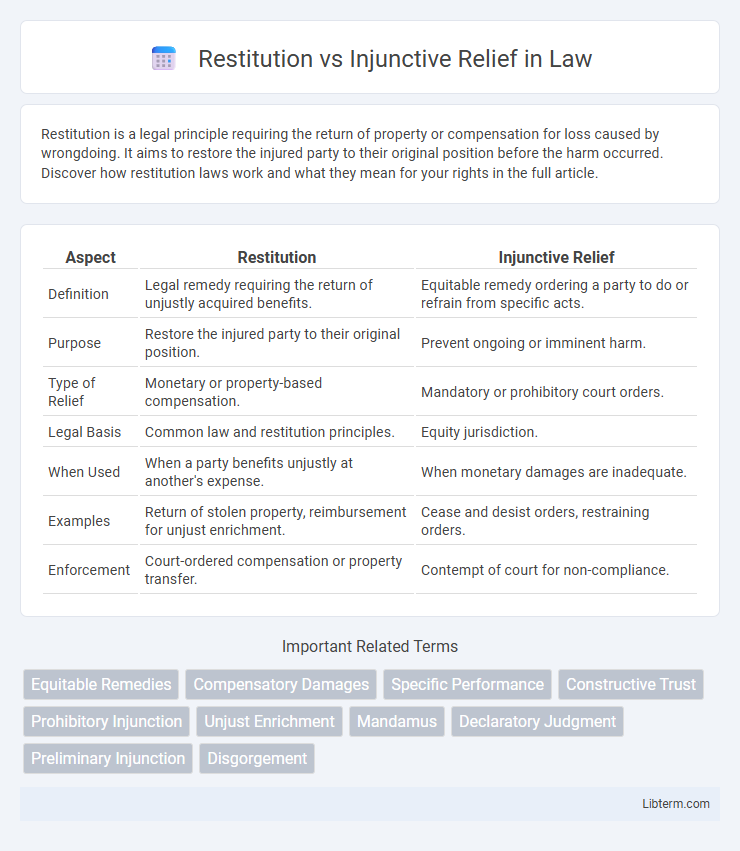Restitution is a legal principle requiring the return of property or compensation for loss caused by wrongdoing. It aims to restore the injured party to their original position before the harm occurred. Discover how restitution laws work and what they mean for your rights in the full article.
Table of Comparison
| Aspect | Restitution | Injunctive Relief |
|---|---|---|
| Definition | Legal remedy requiring the return of unjustly acquired benefits. | Equitable remedy ordering a party to do or refrain from specific acts. |
| Purpose | Restore the injured party to their original position. | Prevent ongoing or imminent harm. |
| Type of Relief | Monetary or property-based compensation. | Mandatory or prohibitory court orders. |
| Legal Basis | Common law and restitution principles. | Equity jurisdiction. |
| When Used | When a party benefits unjustly at another's expense. | When monetary damages are inadequate. |
| Examples | Return of stolen property, reimbursement for unjust enrichment. | Cease and desist orders, restraining orders. |
| Enforcement | Court-ordered compensation or property transfer. | Contempt of court for non-compliance. |
Introduction to Restitution and Injunctive Relief
Restitution involves the return of unjustly obtained benefits to the rightful party, aiming to prevent unjust enrichment by restoring the injured party to their original position. Injunctive relief is a court-ordered remedy that requires a party to do or refrain from specific actions to prevent ongoing or future harm. Both remedies serve distinct purposes: restitution addresses monetary or property recovery, while injunctive relief enforces or prohibits behavior to protect legal rights.
Defining Restitution: Key Concepts
Restitution requires the return of unjust enrichment gained at another's expense, aiming to restore the injured party to their original position through monetary compensation or the return of property. It is grounded in equity principles, emphasizing fairness by preventing unjust enrichment rather than punishing wrongdoing. Key concepts include the identification of a benefit conferred, the absence of a legal justification for retention, and the necessity of providing restitution to avoid injustice.
Understanding Injunctive Relief: An Overview
Injunctive relief is a court-ordered remedy that compels a party to perform or refrain from specific actions to prevent harm or preserve rights. This form of equitable relief is commonly used in cases involving intellectual property, contract disputes, and environmental law to stop ongoing or imminent violations. Unlike restitution, which aims to restore lost benefits, injunctive relief focuses on preventing future harm through proactive judicial intervention.
Legal Foundations of Restitution
Restitution is grounded in equity and aims to prevent unjust enrichment by restoring the injured party to their original position, typically through monetary compensation. Its legal foundation stems from principles of fairness and the recognition that one party should not retain benefits obtained at another's expense without payment. Courts impose restitution when traditional legal remedies, such as damages, fail to fully address the harm caused by wrongful conduct.
Legal Principles Behind Injunctive Relief
Injunctive relief is based on the legal principle that courts can order a party to do or cease specific actions to prevent irreparable harm or preserve the status quo. Unlike restitution, which seeks to restore the injured party to their previous position by recovering losses or benefits unfairly gained, injunctive relief emphasizes preventing ongoing or future harm through mandatory or prohibitory orders. Courts grant injunctions when monetary damages are inadequate, emphasizing equity and fairness to maintain justice in disputes.
Differences Between Restitution and Injunctive Relief
Restitution involves the return of specific benefits or compensation for loss caused by wrongful acts, aiming to restore the injured party to their original position. Injunctive relief commands a party to do or refrain from certain actions to prevent ongoing or future harm, serving as a preventive or corrective measure. While restitution addresses past harm through monetary or property recovery, injunctive relief focuses on controlling behavior to avoid continuous or potential damage.
Situations Warranting Restitution
Restitution is warranted in situations where one party has been unjustly enriched at the expense of another, such as in cases of breach of contract, fraud, or mistake. It compels the wrongdoer to return the benefit gained, restoring the injured party to their original position. Unlike injunctive relief, which seeks to prevent future harm, restitution addresses past losses by mandating monetary compensation or the return of specific property.
Scenarios Requiring Injunctive Relief
Injunctive relief is typically sought in scenarios where monetary damages are insufficient to remedy the harm, such as in cases of ongoing intellectual property infringement, environmental violations, or breach of contract involving unique assets. Courts grant injunctions to prevent irreparable harm, maintain the status quo, or compel specific actions that cannot be adequately compensated by restitution. Examples include restraining the use of trade secrets, stopping unauthorized construction, or enforcing non-compete agreements.
Choosing the Appropriate Legal Remedy
Choosing the appropriate legal remedy between restitution and injunctive relief depends on the nature of the harm and the desired outcome. Restitution aims to restore the injured party to their original position by compensating for losses, making it ideal for financial or property damages. Injunctive relief, which involves court orders to prevent or cease harmful actions, is more suitable for ongoing or future harm requiring immediate intervention.
Conclusion: Comparing Restitution and Injunctive Relief
Restitution focuses on compensating the plaintiff for losses by restoring the value or property taken, emphasizing monetary recovery. Injunctive relief aims to prevent ongoing or future harm through court orders that prohibit or mandate specific actions, prioritizing prevention over compensation. Comparing both, restitution addresses past damages while injunctive relief targets prospective harm, making each suitable for different legal contexts based on the nature of the injury and desired remedy.
Restitution Infographic

 libterm.com
libterm.com